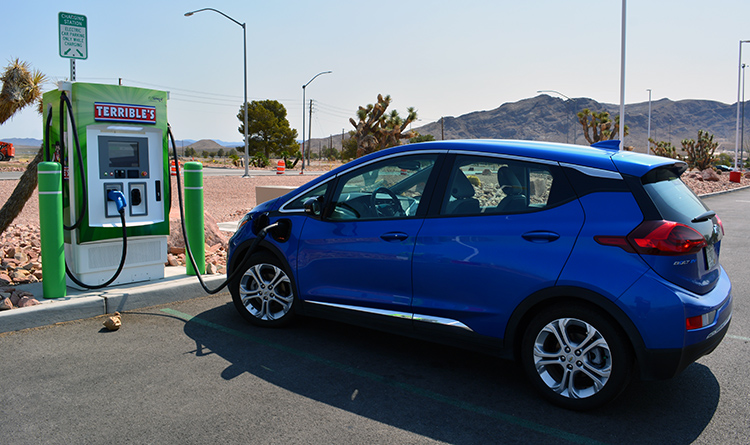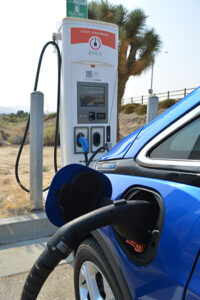
 I recently completed a 1,200 mile drive from Littleton, Colo. to Goleta, Calif. with my teen daughter, Kyra, in a leased 2020 Chevy Bolt. I did the same road trip in a leased 2017 Bolt three years ago.
I recently completed a 1,200 mile drive from Littleton, Colo. to Goleta, Calif. with my teen daughter, Kyra, in a leased 2020 Chevy Bolt. I did the same road trip in a leased 2017 Bolt three years ago.
Generally speaking, this year’s Bolt Littleton to Goleta road trip, taken three years after my first, was a much better experience 🙂. That is the good news, and I write about that in another blog entry.
Here, I focus on the bad news, though … and the bad news is that I, personally, do not think that we can switch to even 33% of all Americans’ long-distance road trips being fully electric, much less 50%, or, god forbid, 80%+ and have it work. Not with the current EV battery technology and charging speeds.
My revelation comes in large part because I am actually out on a long-distance road trip again. LOTS of EV advocates who talk a “good game” about EVs working for long-distance travel for millions of Americans rarely, if ever, actually get out there on these road trips. They need to get out there and see, and experience, all of that traffic on long-distance road trips, really, really see it.
And they all need to spend at least 30 minutes watching the flow of gasoline vehicles zooming into the self-declared World’s Largest Chevron station with 96 gas pumps, The Terrible Herbst installation at Jean, Nev., and take some time to reflect on how that flow is going to look when the vast majority of the traffic flowing into a place such as this is in electric, not gasoline, vehicles.

Even with lots of DCFC stations along major interstates, the vast majority of Americans are still not going to want have to deal with stopping for extra charging sessions because they’re driving 90 mph along the interstate. Charging times — even if we get to a point where we can ALL add 200 miles of range in 20 minutes — are simply too long.
The problem is not so much that people can’t stop for 20 minutes, instead of the five to 10 minutes it takes to pump gas, although this is not going to go over well with many people.
The real issue is that when you actually do the math in your head — millions of people underway simultaneously on long-distance road trips and each having to take at least three, four, five, or more, times longer to fill up — places such as the world’s biggest Chevron station in Jean, Nev., with its mind-boggling 96 gas pumps, turn into massive lines of cars waiting to charge. And that is a good case scenario under which people are getting 200 miles of range in about 20 minutes.
A chaotic disaster if everyone was driving a Bolt
It’s even worse when you think about hundreds of thousands of people driving a fast-charging laggard such as my Bolt, with its 55 kW onboard charger, which takes about 60 to 75 minutes to add about 200 miles of range. That is simply unacceptable.
More important, perhaps, this cannot work on a practical level!
Think about the millions of people who do 600+ mile road trips all having to charge for one hour, or more, every 200 miles. Imagine the lines of people waiting to charge, the anger, the frustration, the bitterness toward a technology that is supposed to be “better” but, really, when measured according to the criterion that matters perhaps most to most people — speed — comes up short, big time, to gasoline cars.
This is especially true when you leap from 1 to 2% of people on long-distance road trips in electric cars right now and scenarios where one is the only person charging, which I often was, to one in which 20% of long-distance travelers need to charge an EV for 20+ minutes, or, one hour+ 😖, to 50%, or 75%, or 100% of long-distance drivers.
Seriously, HOW can this work? The clear answer = It cannot — at least not without truly MASSIVE DCFC stations with, in many cases, hundreds of 350 kW capable slots and 350 kW capable EVs.

In fact, that is oddly kind of a very good thing for people like me, who are out there doing the long-distance EV road trips. If too many people get out there in EVs, the infrastructure won’t be able to handle it and we’ll have to wait, wait, wait to charge behind other EV-ers on long-distance road trips.
Is anyone really thinking about the massive difference between 1% of people on road trips in EVs doing long EV charging sessions every 200 miles and 20, 30, 50, 80, 100 times as many people doing that?
I truly wonder about this — and, frankly, I should, and need to, track down a EV charging infrastructure expert to talk to about this very real problem. And I will do that — just not right now 😉
On the first leg of our trip from Littleton, Colo. to Cedar City, we did not see a single other electric vehicle charging at any of the four DCFC stations we stopped at — all Electrify America stations — in Glenwood Springs, Colo., Green River, Utah, Richfield, Utah, and Cedar City, Utah, where we stayed overnight in a hotel.
We did not see anyone because barely anyone is out there in an EV, Tesla, or non-Tesla, doing long-distance road trips, at least when measured as a total percentage of Americans who are on a long-distance car road trip in any given moment.
Day two, which saw us drive from Cedar City, Utah to Goleta, Calif. was a bit of a different story in terms of seeing other EVs charging: At the Terrible Herbst Chevron Station, a BMI i3 arrived just as I was trying to top off my charge. Out of politeness, I stopped charging — I had wanted to avoid charging again between Jean, Nev. and Palmdale, Calif., which was 208 miles away — and I had to stop again to add another charge about 40 miles down I-15 at the Valley Wells, Calif. rest area. There, too, another EV driver arrived after I had charged about 30 minutes and I stopped then, too, to allow him to charge. He was in a blue 2020 Chevy Bolt just like ours.
How many people are going to want to do what I did — add short, extra charging session bursts in order to clear an EV charging station after they reach 80% charge? How many people are even going to want to deal with the whole 80% charge “deal” and having to learn about that?

As much as I want to see an EV revolution, I just don’t see how it can happen in terms of that most American of traditions, the long-distance road trip, and have it work right now, not with the current comparatively clunky and slow EV fueling system and infrastructure, which is clearly inferior to ICE refueling in terms of long-distance driving, no matter how one tries to spin it.
Faster charging and/or in-road wireless charging needed
We are going to have to develop another way to charge EVs for long-distance trips — maybe in-road wireless charging, battery swapping, and/or charge times that add 200+ miles of range are going to have to come down to five to 10 minutes, or it is not going to work. This, and/or we are going to have to build out DCFC stations with, in many cases, hundreds and hundreds of 350 kW DCFC slots.
Take the 96 gas pumps at the Terrible Herbst Chevron in Jean, Nev. ==>
Assuming 20 minutes to add 200 miles of EV range, which is roughly four times the amount of time it takes to fill an average car’s gas tank, which, we really need to also note, will get almost all gas cars at least 350 to 400 miles of range, or about TWICE as much range as 200 miles, the Terrible Herbst, which currently has just one working DCFC station with a max output of 50 kW, would need to add 350 to 400 DCFC slots in that same spot, with all of these being 350 kW capacity slots, in order to avoid massive lines and chaos during peak fueling times.
How do we get from a place where I, and you, do 600 miles of driving and four hours of charging in a day and do not see a single other EV driver charging at any of the four very limited and small stations — with two to four functioning CCS DCFC stations — to one where ALL of the cars rolling into the Terrible Herbst Chevron in Jean, Nev. and in tens of thousands of similar “pit stop” and refueling spots along thousands of miles of interstate highway in the United States, are electric AND where we do that in a fast, efficient way that does not result in huge bottlenecks of angry and frustrated drivers?
To answer my own question a bit, upon some reflection, and after reworking this blog entry multiple times across the course of a full day, maybe it IS possible to switch America to 100% EVs for long-distance travel.
But, wow, is it going to require an INCREDIBLE build out that really truly boggles the mind: Three to five times as many DCFC slots as gas pumps at every major interstate highway exit along major travel routes throughout the whole country, with these being 350 kW each and ALL of the EVs out there, or at least a large majority, being able to take on a 350 kW charge. Because 55 kW Bolts for everyone and 50 kW DCFC slots everywhere certainly is not going to “cut it”, but instead would create hellish long-distance travel fueling gridlock for all.




